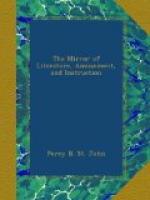“Out of the castle were three passages—one a postern, with an iron gate, on the east side over a private bridge into the park, where there were arbours, pleasant walks, and trees planted for profit and delight. Another passage was on the west side, leading to a dungeon, and forth on to the mere, now filled up with mire and weeds. But the largest passage and most used was, and is, that towards the south and town; there being formerly a portcullis over that gate, which was made in one of the strongest towers, and a drawbridge without, defended by an half-moon of stone, about a man’s height, standing in the year 1657.”
These splendid buildings within the walls have long since been demolished, so that scarcely a vestige remains; but with their materials a workhouse has been built for the poor. The only armorial bearings traceable are three shields over the castle-gate.
Over the centre of the gate is a large one; the arms and quarterings of John Howard IV., first Duke of Norfolk, who died in 1485; and with lions for supporters. Crest—a lion passant-guardant.
1. A bend between six cross crosslets, for ... Howard.
2. Three lions passant-guardant
in pale—England, for ...
Brotherten.
3. Checky ... Warren.
4. A lion rampant ... Mowbray.
5. A lion rampant crowned ... Seagrave.
6. Seme de cross crosslets
fitchy, and a lion rampant, double
queue ...
Broes, or Bruce.
All within the garter.
On the west side, a shield,
quarterly—1. Howard—2.
Brotherton—3.
Mowbray—4. Seagrave.
On the east side, quarterly—1.
Brotherton—2. Warren—3.
Seagrave—4.
Broes.
This venerable and majestic remain of antiquity, when viewed at a distance, has certainly more the appearance of a castle than the ruins of one, the outward walls being almost entire, and presenting nearly the same appearance they did thirty years ago.
Framlingham Church is a fine structure, and was built by the Mowbrays; and the Chancel by the Howards, wherein are several stately monuments of this noble family.
Edward DUNTHORN.
The original of the annexed Cut is a lithograph frontispiece to Framlingham: a Narrative of the Castle—a poem of very considerable merit, by Mr. James Bird, of Yoxford: the introduction to which furnishes the following impassioned apostrophe to Framlingham and its decaying Castle:—
Heir of Antiquity!—fair
castled Town,
Rare spot of beauty, grandeur, and renown,
Seat of East-Anglian kings!—proud
child of fame,
Hallowed by time, illustrious Framlinghame!
I touch my lyre delighted, thus to bring
To thee my heart’s full homage while
I sing!
And thou, old Castle!—thy bold
turrets high,
Have shed their deep enchantment on mine




